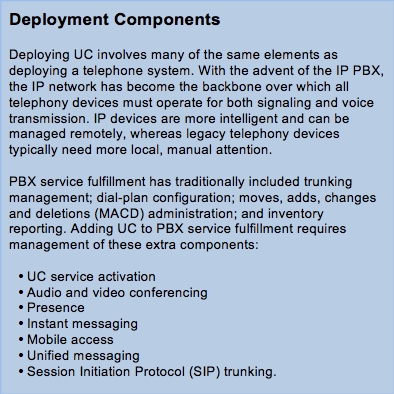- A TechNote on Unified Communications
- Gary Audin, Delphi, Inc.
In every aspect of IT, there are tasks that aren't exciting or glamorous, but a necessary part of everyday operations. In the unified communications (UC) area, service fulfillment is one of those.
Delivering telephony and UC services has traditionally involved inputting detailed configuration, privilege and restriction information to multiple application systems. It's time-consuming to do manually, prone to errors that can mean costly service delays and requires a skilled engineer.
However, successful service fulfillment can lead to reduced total cost of ownership (TCO), faster service change response, fewer errors and greater user satisfaction. So to improve the chances for success, automation systems for UC fulfillment in the enterprise have begun to emerge, as demonstrated at the Enterprise Connect 2012 conference last month in Orlando.
Multi-Vendor Automation
 UC fulfillment is the process of delivering integrated, IP-based telephony-centric services - such as voice, video, instant messaging (IM), conferencing and presence - to customers in a timely and accurate manner. These services might be provided by a single vendor, multiple vendors and/or a cloud service.
UC fulfillment is the process of delivering integrated, IP-based telephony-centric services - such as voice, video, instant messaging (IM), conferencing and presence - to customers in a timely and accurate manner. These services might be provided by a single vendor, multiple vendors and/or a cloud service.
Automated service fulfillment software systems have existed for many years in the telecom service provider space. They have now entered the enterprise communications market. For example, at last month's Enterprise Connect 2012 conference, companies such as VOSS Solutions and Unimax demonstrated systems that can manage UC service fulfillment across multiple vendors' systems and cloud services.
Three Main Drivers
It is logical that automated service fulfillment systems should find their way into the enterprise communication market. There are three main drivers:
Delivering telephony and UC services has traditionally involved inputting detailed configuration, privilege and restriction information to multiple application systems. It's time-consuming to do manually, prone to errors that can mean costly service delays and requires a skilled engineer.
However, successful service fulfillment can lead to reduced total cost of ownership (TCO), faster service change response, fewer errors and greater user satisfaction. So to improve the chances for success, automation systems for UC fulfillment in the enterprise have begun to emerge, as demonstrated at the Enterprise Connect 2012 conference last month in Orlando.
Multi-Vendor Automation
 UC fulfillment is the process of delivering integrated, IP-based telephony-centric services - such as voice, video, instant messaging (IM), conferencing and presence - to customers in a timely and accurate manner. These services might be provided by a single vendor, multiple vendors and/or a cloud service.
UC fulfillment is the process of delivering integrated, IP-based telephony-centric services - such as voice, video, instant messaging (IM), conferencing and presence - to customers in a timely and accurate manner. These services might be provided by a single vendor, multiple vendors and/or a cloud service. Automated service fulfillment software systems have existed for many years in the telecom service provider space. They have now entered the enterprise communications market. For example, at last month's Enterprise Connect 2012 conference, companies such as VOSS Solutions and Unimax demonstrated systems that can manage UC service fulfillment across multiple vendors' systems and cloud services.
Three Main Drivers
It is logical that automated service fulfillment systems should find their way into the enterprise communication market. There are three main drivers:
- Need to ease complexity. Unified communications services can add complexity to an already complex IP voice infrastructure. Organizations need to hire skilled engineers to run these platforms and ultimately become dependent on those key engineers. But many administration tasks are highly repetitive and mundane, diminishing engineers' job satisfaction. By taking over these repetitive tasks, automated UC fulfillment systems help standardize configurations, lower the risk of manual error and reduce an organization's dependence on key staff engineers.
- Need for centralized management. Enterprises understand the inefficiency of each business unit, agency or location operating its own communication system. As more sophisticated enterprise architectures are implemented, multiple business units are supported from a central data center. Central IT organizations can be responsible for the entire enterprise-wide communication platform, delivering advanced services to the separate business units much like a mini service provider. However, if a local business unit wants to maintain control of mission-critical communication services, its IT team can manage its own services and users while also sharing a central network infrastructure.
- Agility. It has become unacceptable for users to have to wait 24 to 48 hours for a communication service change in the current world of instant online access. IT departments are under pressure from cloud providers to offers users access to a business portal to manage their own services in real time. Service fulfillment systems provide a business layer with a real-time administration portal for end users.










